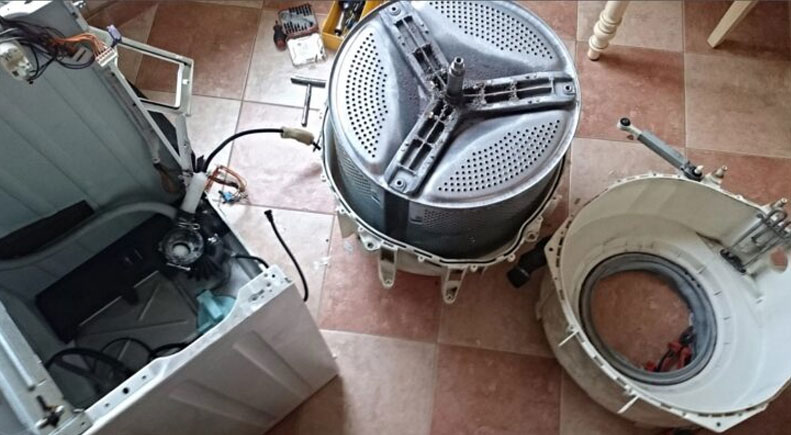
Using a cross, the drum is attached to the tank. During each wash, the part experiences enormous stress. Therefore, over time it may become deformed or burst. If the crosspiece in the washing machine breaks, you need to immediately replace the part. It is not advisable to try to repair it - it is not a fact that after a couple of washes, the device will not fail again. We will tell you how to get to the element and where to look for it.
If the drum cross has burst, you will have to replace the part. It is prohibited to operate a washing machine with such a breakdown; this can lead to complete failure of the equipment. To get to the damaged crosspiece, you need to completely disassemble the body of the automatic machine.
Also, preparing the machine for disassembly will include draining the remaining water from the system. To do this, unscrew the plug of the rubbish filter. Then collect the liquid that flows out of the hole into a basin.
What to do next? Move the home assistant away from the wall so you can access it from all sides. Further:
Now nothing will interfere with the removal of the tank - it will remain hanging on special hooks. It is more convenient to reach the plastic tank through the front of the washer. You need to slightly lift the knot and pull it towards you.
What to do next? The cross is located inside, so the container will have to be halved. If the washing machine is equipped with a collapsible tank, then it is enough to remove all the screws around the perimeter of the tank and gain access to the drum. First, you need to remove the pulley from the tank. To do this, unscrew the screw holding the “drum wheel.” Next, remove all the screws around the perimeter of the plastic container, remove the latches and halve the container. This way you can get to the drum.
Some machines are equipped with non-separable tanks. In this case, you will have to see the container with a grinder exactly along the weld seam. Subsequently, the structure is assembled, and the halves of the tank are fastened together with moisture-resistant sealant and self-tapping screws.
Once you have access to the drum, inspect the cross. After doing this work, you will find that the part does not require replacement at all. Then the reason for the “whims” of the washing machine will be broken bearings - check them too. If the crosspiece bursts, you will have to replace it. Buy a new part that is the same as the one you are removing. It is important to select components for a specific model of washing machine.
The crosspiece is fixed to the drum with three bolts. After using the washing machine for a long time, the screws may “stick” and unscrewing them will be very problematic. WD-40 aerosol lubricant will help deal with “stuck” screws. Treat the desired area with the product and let the composition act for 20-30 minutes. The scale and plaque will liquefy, so you can safely remove the screws.
To dismantle the crosspiece, arm yourself with a small hammer and a slotted screwdriver. Gently tap the part, prying it up. This will cause the element to fly out of the grooves.
Install a new crosspiece, then assemble the tank, return it to its place, and connect all the previously removed wires, pipes, sensors, and elements. Fix the control panel, and secure the front, back and top walls of the case. Run a test washing mode and observe how the “home assistant” behaves after the repair.
Copyright © 2020 Coimbatore Service.